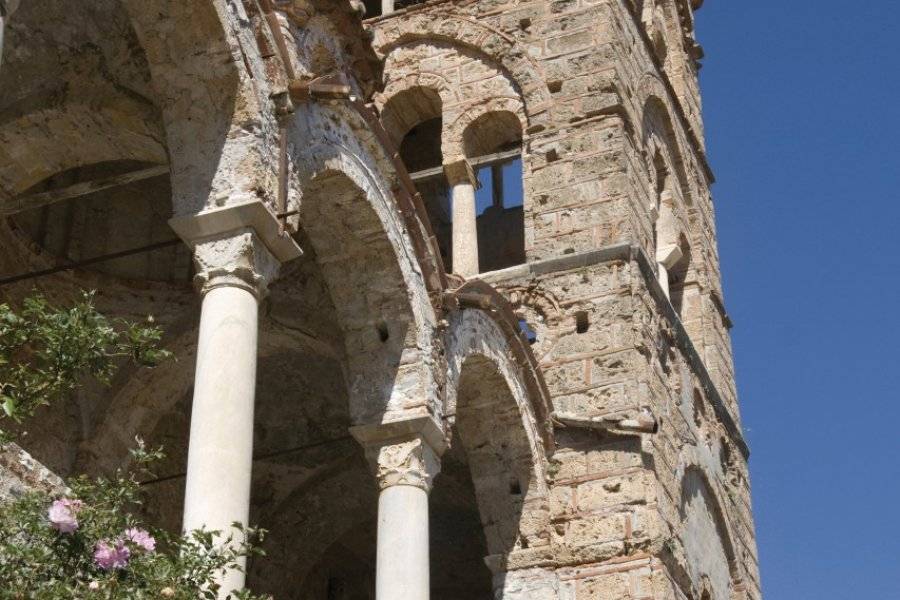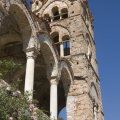MYSTRA ARCHAEOLOGICAL SITE
Unesco World Heritage site. Ancient Byzantine town built on a hill in the centuries. Castle, churches..
Listed as a Unesco World Heritage Site since 1989, this site (Αρχαιολογικός Χώρος Μυστρά/Archaiologikos Choros Mystra) is home to the superb remains of the Byzantine city of Mystra. It was originally a castle founded in 1249 on the steep hill of Myzithras by the Frankish prince Guillaume II de Villehardouin. Taken prisoner, he was forced to cede Mystra to the Eastern Roman Empire ten years later. This so-called "Byzantine" empire was in the process of being reconstituted, following the capture of Constantinople by the Crusaders in 1204. Mystra became an important intellectual, religious and military center, and later the capital of the Despotate of Morea, the Byzantine province of the Peloponnese. The hillside and surrounding area were covered with prestigious churches, aristocratic residences and the homes of Laconians fleeing the yoke of the Franks. In just a few decades, Mystra became a city of 40,000 inhabitants. In 1460, it was the last bastion of the Empire to fall to the Ottomans, seven years after Constantinople. It was largely destroyed in 1825, during the Greek War of Independence.
Castle. Today, Mystra is a splendid but demanding site to explore, with distinct places to visit and steep slopes to climb on foot. Allow 3 or 4 hours with two short car journeys and all the gear for walking in the heat: good shoes, headgear, water, etc. First, drive around the hill (3.7 km from the actual village of Mystra) to reach the parking area to the west. From here, if possible in the morning, before the heat of the day, start at the castle, the highest part of the site. Perched at an altitude of 681 m, it sits atop the Myzithras hill, which may owe its name to its "breast" shape(mazos in ancient Greek). Built by the Franks, then reworked by the Byzantines and Ottomans, the complex retains its crenellated double enclosure and offers grandiose views of Taygetos, the Laconian plain and vertiginous peaks. Among the ruins, signs indicate the site of the Villehardouin palace, which became the residence of the Ottoman governors. Go back down the same path and turn right before the parking lot.
Upper town - Byzantine palace. A paved path now leads down through the upper town. The first major building is the Agia Sofia church, erected in the mid-14th century. Beneath its dome, polychrome marble bas-reliefs and fragments of frescoes (Christ in Majesty, Virgin Birth...) remain. Next comes the palace of the Despotate of Morea. Built in 1348, it consists of two three-storey wings with Gothic windows overlooking an esplanade where parties and assemblies were held. After ten years of restoration work, the palace will house the new Mystra Archaeological Museum from 2025. The path then descends through the Nafplio Gate, which guarded the entrance to the upper city. Finally, you come to the beautiful Monemvassia Gate, the only link between the upper and lower parts of ancient Mystra. Now it's time to return to the parking lot and take the road to the east, to the foot of the hill where the vast lower town lies.
Lower town - Perivleptos monastery. Access to the lower town starts from a parking lot above the Xenia restaurant, then via a 13th-century castle. Head south. The path runs alongside an Ottoman fountain and the ruins of the 14th-century Laskaris manor house: the courtyard housed a chapel, the first floor was used as a stable, the second floor as a warehouse and the third floor as the home of a Byzantine aristocratic family. Continue 200 m past the 14th-century Agios Christoforos and 13th-century Agios Georgios chapels. South of the lower town, you come to the Perivleptos monastery. Dedicated to the Virgin Mary "seen from everywhere", it was founded in the 13th century, and its catholicon (main church) preserves precious frescoes in vivid colors: cycles of the life of the Virgin Mary, the life of Christ and the Passion, representations of the twelve major feasts of the Orthodox liturgical calendar... Painted in 1348 and 1380, they are one of the finest testimonies to late Byzantine art with Western influences that herald the Renaissance. In the apse, note two processions of angels from the Divine Liturgy (the Eucharist): the draping of the vestments gives a striking impression of movement.
Lower town - Pandanassa monastery. Now head north-west. The path runs alongside the remains of the Frangopoulos house. It belonged to Ioannis Frangopoulos, who was Protostrator ("Prime Minister") of the Despotate of Morea. It was he who financed the construction of the Pandanassa ("Queen of the Universe") monastery, completed in 1428. Set on the side of the Myzithras hill, 425 m above sea level, it dominates the whole of the lower town, with a 60 m long building and an imposing Gothic bell tower-porch with richly sculpted decoration. It is the only active monastery in Mystra, with a community of nuns. Under the dome and four domes of the catholicon, the 15th-century frescoes are well preserved. The Italian Renaissance is just around the corner, with an attention to detail never before seen in Byzantine art.
Lower town - Vrontochion monastery. Below the Monemvassia gate and the Despotat palace, the path to the north of the lower town begins. Beyond scattered ruins stand the two churches of the Vrontochion monastery, founded in the 13th century. The largest, that of the Odigitria ("Virgin Leader"), was built shortly before the monastery was founded and financed by a Byzantine nobleman, whose surname appears in an inscription: Vrontochios. It retains its typical Mystra architecture (basilical plan with three naves separated by two rows of columns) and superb 14th-century frescoes worthy of Giotto, the Italian master of the pre-Renaissance period: portraits of the Church Fathers, scenes of Christ's miracles. To the left of the narthex, a chapel houses a magnificent fresco of the Procession of the Martyrs and two tombs, those of the monk Pachomios, founder of the monastery, and Prince Theodore II Palaeologus, who ruled the Despotate of Morea from 1407 to 1443. The monastery's other church, Agii Theodori, dates from the late 13th century. Dedicated to the saints Theodore Tiron and Theodore the Stratilate, it boasts the highest dome in Mystra, whose cap is adorned with a majestic Christ Pantocrator ("almighty"). Once home to a large library, Vrontochion was the "university" of Mystra. In the early 15th century, it was here that the philosopher Plethon advocated a return to Greek polytheism in order to save the Byzantine Empire, then on the verge of collapse. Accused of heresy, this atypical intellectual nevertheless enjoyed the protection of Emperor Manuel Palaeologus, who even entrusted him with a reform of the Empire based on Plato's texts.
Lower town - Agios Dimitros church. Heading back towards the entrance, you first pass by the Church of Evangelistria ("Annunciation"), which boasts a number of frescoes painted around 1400, and then the complex of the Church of Agios Dimitros. Built in the late 13th century, it was the seat of the metropolis (archbishopric) of Mystra. From the courtyard, a staircase leads down to the church. It was remodeled in the 15th century, with the addition of cupolas and a gynaeceum, a tribune for women. From its origins, it retains a polychrome marble pavement, eleven scenes from the martyrdom of Saint Demetrios of Thessalonica (north aisle) and a grandiose representation of Hetimasia (south aisle) with the empty throne symbolizing the expectation of the Last Judgment. Next door, an 18th-century building houses the current small archaeological museum, which exhibits objects discovered throughout the site: a 14th-century bas-relief depicting Alexander the Great, richly illuminated Bibles, and the dress and hair of the "Mummy of Mystra", the remains of Cleopa Malatesta, the Italian wife of Prince Theodore II, buried in 1433.
Did you know? This review was written by our professional authors.
Members' reviews on MYSTRA ARCHAEOLOGICAL SITE
The ratings and reviews below reflect the subjective opinions of members and not the opinion of The Little Witty.





Il faut beaucoup de temps pour parcourir le lieu en allant d'églises en église...Certaines qui contiennent de belles fresques sont fermées mais il y en a beaucoup d'ouvertes.
Le seul monastère encore habité est perché mais quand nous sommes arrivées un peu fatiguées et assoiffées, une nonne nous a proposé de nous asseoir et nous a offert une boisson fraîche.
Le fléchage des différentes églises n'est pas parfait...
Eviter d'y être aux heures les plus chaudes...
Il y a deux entrées. Pour atteindre la ville haute peut reprendre la voiture. De la route on a une vue magnifique sur l'ensemble du site.
Prévoir de l'eau (surtout l'été) et de bonnes chaussures car la visite est assez éprouvante.
Il se décompose en deux parties distinctes (parties haute et basse):
- une forteresse médiévale donnant une vue imprenable sur les alentours
- un ensemble d'églises byzantines
Compter entre 4 et 5 heures de visite.
Prévoir une nuit sur place si l'on vient de loin.
Conseil: laissez la poussette pour la forteresse...mais vous pouvez la prendre pour la partie basse
Prix du billet 12€. Gratuit pour les enfants. Parking gratuit. Un pour chaque partie.